Mary the Magdalene,
A Christian Goddess in the Bible
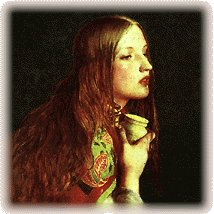
Visit our Order of Mary Magdala
Free Lessons Restoring the Sacred Feminine to Christianity
Visit Magdalene Art Gallery
Read the Mary Magdalene Blog Posts on Katia’s new Esoteric Christianity Blog.
Articles & Poems on this Page:
Magdalene was a Christian leader,not a repentant prostitute
Hearing Whispers of Mary Magdalene’s Voice
Temple Priestesses, Mother Mary and Mary Magdalene?
The Sacred Reunion by Margaret Starbird & thoughts on Derelicta, by Botticelli
Hearing Whispers of Mary Magdalene’s Voice
Mary We Did Not Know You
By Maya, Priestess, Order of Mary Magdala
Mary, we did not know you.
Kept hidden for centuries you were despised,
A Queen not seen, under harlot’s disguise.
Mary, we did not know you.
No Wife has He, we were told.
No Priestess, no Bride, no Queen, He was alone.
They dressed you in rags, royal purple not shown.
Mary, we did not know you.
My heart weeps for what was lost.
How we treated you, Divine Daughter on High.
I search Heaven and Earth and ask myself, why.
Mary, we did not know you.
May we now bring wrong to right.
We will sing of Your Queenship for all to hear.
We will ring your truth, north, south, far and near.
Mary, now all may know you.
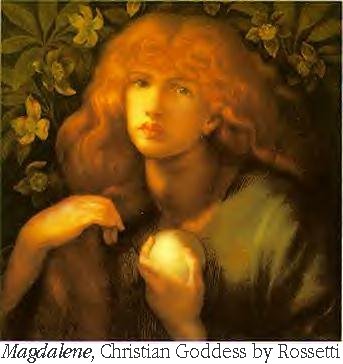
She is likewise the woman who has long haunted the dreams and waking hours of actress Anita Stenger Dacanay.
After a year of reading every book she could corral about Mary Magdalene — both scholarly and fictional — Dacanay wrote a play about her, titled “Qadishtu.” The word is Akkadian, the Semitic language of Mesopotamia, and refers to women who lived in temples in the goddess-worshiping civilizations of the Holy Land and parts of the Middle and Near East.
Scholars have labeled these women “prostitutes,” probably because of their liberal sexual practices, Dacanay believes. Yet she has learned that the literal translation for qadishtu is “sanctified” or “holy women.” What if these women were, as some scholars hold, priestesses in the tradition of goddess worship? Could Mary Magdalene have been one of them? What was her relationship to Jesus? These are some of the questions that Dacanay, who performs the one-woman show, raises with her audience.
The playwright is also concerned about Mary’s significance to women of today. She’s convinced that Mary Magdalene represents every Christian woman. Her depiction as a sinful penitent — the classic fallen woman — is part of the heritage that has been yoked to women in the church for centuries, up to and including our own, Dacanay said.
She spoke with NCR at JFK International Airport here in February en route to Chicago, where she lives with her husband, Gary. Dacanay is a member of the Still Point Theatre Collective, a ministry of St. Stephen’s Lutheran Church in suburban Lincoln Park.
The actress has been touring with the company’s “Points of Arrival; a Jean Donovan Journey.” The play depicts one of the four American religious women raped and murdered by Salvadoran soldiers in 1980.
A cruel, distant god
Whether in Chicago or on the road, Dacanay, 32, admits to a 15-year struggle to reconcile the anger she has felt toward the Catholic church in which she was raised and her deepening relationship with the person of Jesus. “I believe the greatest abuse I suffered as a child, an adolescent and an adult was the idea propounded by my mother, the church and society that God was a man,” she said.
Dacanay felt that God the Father “represented something cruel and distant and very male” — a God who could extract a “horrible” death from his beloved Son. By contrast, she found Jesus’ humility, grace, compassion and courage to be qualities more common to women than to men, she said. “In Jesus I was able to see a bit of what I could truly be if I learned to love well.”
The playwright described the birthing of her drama as “excruciating” and watched herself “vacillate between excitement and sheer terror.” Prayer, meditation, reflection along the shore of Lake Michigan and hearing Mary Magdalene’s voice “in snippets and whispers” all went into the work, she said.
Dacanay wondered if the reason for Christ’s great love for Mary Magdalene was “because she possessed her own spiritual strength and wisdom, because she herself was a child of the Goddess, [a child] who knew and claimed her rightful place on earth and who refused to apologize to the men in power in Jerusalem for being a strong, self-actualized woman.”
Dacanay’s probings lead her to “despise and disclaim” the “prophetic slut” image that she said the church has imposed on Mary Magdalene only to have it taken up in pop culture. The readings started her on a journey of recognition and worship of the feminine divine. Dacanay said that her spiritual searchings were not so much attempts to find a new religion, but to discover how so many had embraced a creed that so suppresses women.
For her, religion is at best a vessel in which to hold our faith. It gives us a structure, guidelines and a path by which to express our souls, she said.
A new consciousness
On her way to rediscovering the feminine divine she talked of detours she’d made into Native American spirituality, New Age, Buddhism, yoga and most recently Wicca — all of them leading her to an awareness of the divine feminine and of the holiness of all creation, she said. Dacanay is convinced that a new feminine divine consciousness is forming on the planet.
The fact that many other women also identify with this concept is, she said, a result of their struggles, their feelings of alienation and loneliness, and their choosing at times solitude and at other times sharing, but always an interconnectedness to the divine. For Dacanay, the divine includes and reveres the feminine alongside the masculine.
Millennias of patriarchy and church teaching — from the evils attributed to Eve, the first mother, to the Catholic church’s perception of women as unfit for priesthood today — have silenced the souls of many women, she fears, and have caused them to feel unworthy. Dacanay was reduced to sobs last year when attending Mass in Toronto and hearing the words: “Lord, I am not worthy.” It echoed much of the patterning of her youth and of her Ohio Catholic school education, she said.
Still, on that trip, she made friends with a Canadian Jesuit who has helped her find peace while mourning the loss of the religion that has played such a large role in her life. Perhaps that is why the last scene of “Qadishtu” has Mary Magdalene kneeling to wash feet. Even though some who’ve seen the play in Baltimore and Chicago have been troubled by such a depiction, Dacanay sees it as the place where forgiveness can occur and where women’s work of caretaking for others across the ages is acknowledged.
The actress-playwright has layered “Qadishtu” with elements drawn from both goddess religions and Christianity, employing songs, readings and audience participation rituals in the hope of creating a healing ceremony as well as an interesting piece of drama. Over 75 minutes she has the character of Mary Magdalene lead the audience through the story, and she invites them to worship with her. Interspersed are monologues chronicling Dacanay’s own faith journey in writing the play.
The Sacred Reunion
by Margaret Starbird from her must-have book The Woman with the Alabaster Jar
Shrouded in mists of time
she waits alone in the garden,
veiled, her name obscured,
the forsaken Rose.
Lost counterpart of Logos, the Word,
Son of the Father,
reason and righteousness,
the eternal He.
Forgotten Eros,
the passionate one,
the eternal She,
left prostrate on the ground.
“The Bride is as dark—
but lovely—
as the tents of Cedar.
Do not stare at her because she is swarthy,
because the sun has burned her.
She has labored in her brothers’ vineyards;
her own she has not kept.” (Cant. 1:5-6)
The Bride,
parched from her toil
in the scorching sun,
dark, dried, and withered.
Black Madonna,
mother of the afflicted poor,
God’s raisins,
burned in the relentless rays
of Logos, victor, judge, and sword.
Male image of a sovereign God
raised to heaven’s throne—
alone.
Eagerly she sought him,
but watchmen came upon her,
struck and wounded her,
the guardians of the walls.
Her plight is mirrored now
in Czestochowa’s icon,
a gash upon her cheek,
the abused, abandoned one—
the Derelicta.
Noli me tangere:
“Do not touch me,”
For centuries the echo:
Noli me tangere.
The Ascended One,
adored and glorified—
untouchable,
the handsome prince,
Lion of Judah and Lamb of God
seated at the Father’s hand
and ruling from his throne—
alone.
But now, at last, he seeks her.
He calls for her.
He knows the name of the Rose.
Exhausted and parched
in wretchedness,
she hears him call her name.
She stirs, raises her head, and looks around.
“Who speaks?”
Her heart beats faster.
“Can it be he?
Has he returned at last for me?”
The garden where he left her
is now a wasteland—
scarred, dried, and shriveled.
Trees are stunted,
streams of living water
only a trickle.
Thickets of thorn
surround the garden,
barring his way.
With the sword of truth
he must hack them to pieces
to reach his beloved.
At last he finds her,
still clasping her alabaster jar.
Her joyful tears fall at his feet.
A second time she dries them with her hair.
But now he reaches for her hand.
“Come, beloved; it is time.
Let us go together into the vineyard
to see if the vines are in bloom.” (Cant. 7:13)
Hand in hand now,
they walk in the desert garden.
And where their feet tread
a violet springs up from the ground,
an anemone lifts its head.
In their wake
buds swell on barren bough.
“No longer will you be called ‘forsaken’
and your lands ‘desolate,’
but you shall be called ‘beloved,’
and your lands ‘espoused'” (Isa. 62:4)
He whispers her name,
savoring its taste
delighting in the Bride of his longing.
Mary…
A wise, complex woman
The work explores such spiritual themes as love, loss, forgiveness, healing and resurrection. To date the show has raised many questions from its different audiences, just what Dacanay intended. Her goal was not necessarily to provide a more sympathetic understanding of Mary Magdalene, but to show that her story and that of many women have been oversimplified and not given the credit they deserve, she said.
Whoever Mary Magdalene was, “I know she was more wise, more complex and more wonderful than the two-dimensional view of her that has come down to us. … If I on a microcosmic level can create something that never existed before, then on a macrocosmic level we can create something new and better together,” Dacanay told NCR. What she wants is a world of peace.
For women, it just might have to begin with peace between the sexes, she said. The age-old gender war is both unnatural and manmade, she said. “It’s about culture and learned behavior” that have been the norm of patriarchy for only 5,000 years. What’s required for peace is to step away from the paradigm of one person having to be over another to survive, she said.
Dacanay believes that such a peace “can break out at any time.” It only requires “a community in which everyone is revered, respected and esteemed.”
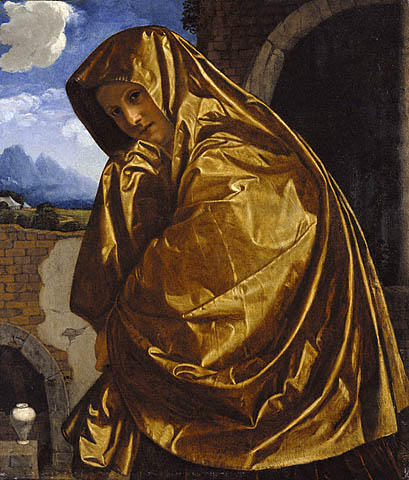
Temple Prostitutes, Temple Virgins, were they Temple Priestesses?
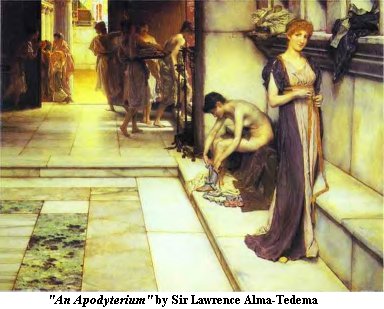
We know there was the Women’s Court at both Solomon’s Temple and the Second Temple in Jerusalem, and we know there is mention of the practice of sending young women there to “work.” Mother Mary is said to have been dedicated to Temple work, she lived there, wove tapestries, altar cloths, prayed for the betterment of the people, etc. She is repeatedly called a “Temple Virgin” and apocryphal books tell of her adventures there under the Highpriest Zacharius. [Gospel of the Birth of Mary, written 300’s AD, supposedly written by Matthew, and the Protevangelion, written by James, Yeshua’s brother, one of Mary’s other sons]. At one point another priest, Abiathar, wants Mary, known as a magikally powerful and beautiful priestess, to marry his son.
Truly sacred prostitutes existed in past cultures, like the heterae of Greece and the shaktis of India. In fact, the words “prostitute” and “prostitution” have such an indelibly negative imprint in the modern Western mind that in order to properly grasp the meaning of these things we should resort to one of the older terms — so I’ll use “hetera” and its derivatives.
So: the purpose of heterism is not mere sexual gratification, but first of all healing, and secondly transcendence. In the first function, the hetera is what we would today call a therapist, who specializes in the use of sex to accomplish the aim of healing. The second function [transcendence] has been practically forgotten in the postmodern world, and can only be understood in a societal context where the higher forms of spirituality are practiced. The process of negating the ego to perform selfless service to God and his children is only known in the West in a matrix of ascetic monasticism; but there have been, and are, other cultures where these same principles are applied in a specialized form of sexual relationships — namely, heterism in its higher form, in which it can not only heal people of pathologies, but help them transcend the human condition and become better than they could ever hope to be in “normal” life.
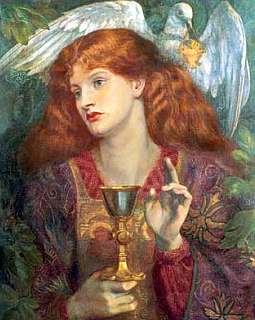
Magdalene was a Christian leader, not a repentant prostitute
By Victor Greto, for The Gazette
Who is Mary Magdalene? A prostitute and sinner who repented after Jesus saved her from being stoned by a mob — the same Mary who then saw the risen Christ first?
According to some Christians and scholars, it’s time to rethink the prostitute and stoning stuff.
Mary Magdalene is becoming a role model for women who expect more important roles for themselves in their respective churches. And scholars use Mary Magdalene as a symbol of the important role of women in early Christianity, as they work out the implications of recently discovered ancient literature.
The current reform of Mary Magdalene has centuries of church and art tradition to overcome. The non-biblical image of Magdalene as a repentant prostitute is an image that had been officially sanctioned by the Roman Catholic Church in the sixth century. And it’s that image that has been perpetuated by dozens of Christian paintings and movies ever since.
The misreading of Mary Magdalene, critics say, is almost as ancient as the Gospels of the New Testament themselves, if only because there are up to five different Marys in the Gospels and seven in the New Testament as a whole.
The greatest damage done to Magdalene’s reputation, however, is only partly the confusion of these Marys, says Sister Evelina Belfiore, director of Catholic education for the Colorado Springs, Colo., diocese. The main problem is the way some decided to identify an unnamed woman with Magdalene in the Gospel of Luke.
In 7:37-38, Luke tells the tale of a woman, “a sinner” who goes into a dinner party and anoints Jesus’ feet. The following chapter immediately introduces “Mary, called Magdalene, from whom seven demons had gone out. . . .”
“In the early church,” Belfiore says, “as people have placed her in art and legend and misinterpretation, they linked her with the sinner from the chapter before.”
Take Martin Scorsese’s `Last Temptation of Christ’ as one of the more recent examples. In the film, based on the Nikos Kazantzakis novel, Magdalene is portrayed as a prostitute and is identified with another episode often included in the Gospel of John 8:3-11, in which Jesus stops a crowd from stoning a woman for prostitution. There is no indication in the text that either unnamed woman is Magdalene, but tradition has linked her with Magdalene.
Why?
That link, Belfiore says, came about in the early church of later centuries “and may have been associated with the oppression of women. Before that, women were ordained deaconesses. Then, there was a turnabout, excluding women from the sacred and from orders. Mary Magdalene had such a privileged role in the Gospels that it seems there was an attempt to put her in a bad light.”
Which is exactly what Sister Christine Schenk says she is trying to reverse. Schenk is executive director of the Cleveland-based FutureChurch.
Two years ago, Schenk’s group in conjunction with another Catholic group, Chicago-based Call to Action, launched the national observance of a July 22 feast of Mary Magdalene. It has grown from 28 prayer services last year to a reported 100 services this past July.
“The Mary Magdala project emerged,” Schenk says, “because it makes contemporary biblical scholarship available, and it provides woman ministers to preside at a prayer service.”
Schenk says her group is not calling for women’s ordination but for “women’s equal call to ministry in the Catholic Church.”
Schenk said the Magdalene services include a “brief reflection on Mary of Magdala,” and what she calls “the right of naming.” That is, when Jesus calls Magdalene by her name in the Gospel passage John 20:17, “she recognized him” as the risen Christ, and she was called as a disciple.
Schenk thus sees Magdalene as representing a woman’s call to discipleship. In the past, she says, women have internalized the idea that they weren’t as holy or as good as men. The Magdalene services are “a real healing for many participants,” she says.
The emergence of women in organized religion is not only a Catholic issue.The Rev. Patricia Westlake of Trinity United Methodist Church in Colorado Springs, Colo., says she believes Magdalene was present at the Last Supper.
And she believes other female disciples were on a par with the more famous 12 male apostles. In two of his letters, St. Paul also mentions important women of the early church. “For me, the Scriptures give [women] a prominent role,” Westlake says. “Jesus gave them a prominent role. It’s our culture that doesn’t give them a prominent role.”
Feminist scholars of early Christianity see Mary Magdalene as indicative of what happened to women in general in the early church. “In the last twenty years, the history of women in ancient Christianity has been almost completely revised,” writes Karen King in a recent essay about women in early Christianity. King is a professor of New Testament Studies and the History of Ancient Christianity at Harvard University’s Divinity School.
King writes that the early Christian women we thought we knew have almost nothing to do with the revised portrait that scholars are just beginning to unveil. “Chief among these is Mary Magdalene,” she says. “Discoveries of new texts . . . have now proven that [her reputation as a repentant prostitute] is entirely inaccurate. She was indeed an influential figure, but as a prominent disciple and leader of one wing of the early Christian movement that promoted women’s leadership.”
Among the newly discovered texts King is referring to is `The Gospel of Mary,’ discovered at Nag Hammadi in Egypt more than a half-century ago. In that Gospel, Mary receives secret revelations from Jesus — much to the chagrin of Peter.`The Gospel of Philip,’ also discovered at Nag Hammadi, shows yet another understanding of Mary’s relationship with Jesus.
“But Christ loved her more than all the disciples and used to kiss her often on the mouth,” that Gospel reads. “The rest of the disciples were offended by it and expressed disapproval. They said to him, `Why do you love her more than all of us?’ The savior answered and said to them, `Why do I not love you like (I love) her?’ ”
Scholars say they are not arguing that these are historically truer portraits than those of the New Testament Gospels. But they argue that these Gospels show there were early Christian communities that traced their beliefs back to a figure known as Mary Magdalene — which had nothing to do with the traditional figure of a repentant prostitute.
Even those women in established religions who do not accept the non-canonical Gospels as legitimate sources see hope for women in a closer reading of the four Gospels of the New Testament. “I think she’s a model for women today,” Belfiore says of Magdalene. “That when Jesus spoke to Mary to go tell the other disciples he was risen, it shows that woman has a complementary role in the mission and that we need one another. It’s not a man’s church or a woman’s church, but a church. Women have a specific dimension of the mission.”
Mary Magdalene meets Tiberius
A “legend” taught by the Eastern Orthodox Church for over 1500 years
According to the ancient tradition of the East, Mary Magdalene was a wealthy woman from whom Christ expelled seven “demons.” During the three years of Jesus’ ministry she helped support him and his other disciples with her money. When almost everyone else fled, she stayed with him at the cross. On Easter morning she was the first to bear witness to his resurrection. She is called “Equal to the Apostles.” The Eastern tradition tells us that after the Ascension she journeyed to Rome where she was admitted to the court of Tiberius Caesar because of her high social standing. After describing how poorly Pilate had administered justice at Jesus’ trial, she told Caesar that Jesus had risen from the dead. To help explain his resurrection she picked up an egg from the dinner table. Caesar responded that a human being could no more rise from the dead than the egg in her hand turn red. The egg turned red immediately, which is why red eggs have been exchanged at Easter for centuries in the Byzantine East.
Mary traveled the Mediterranean preaching the resurrection. Like Peter and Paul, she died a martyr and she bears witness to the important role women once held in the Church.
This icon (on the front of the card) was commissioned for Grace Cathedral in San Francisco to commemorate the election of Barbara Harris, the first woman bishop in the Anglican communion. As women reclaim their ancient rights in the church, Mary Magdalene challenges all Christians to re-examine their cultural prejudices about gender and leadership. — From the back of my Society of Mary Magdalene membership welcome card
The Eastern Orthodox Church, which includes the Russians, is indeed fond of blood red eggs at Easter. Gold letters are painted onto the red eggs. They make red eggs every year, no pastels. You have to start with a brown egg in order to get the rich dark red color.
[In the Tiberius red egg legend, no mention is made of Mary Magdalene’s marriage to Yeshua/Jesus. That part of the story has been suppressed, but kept alive by gnostics and heretics becoming one of the secrets of Esoteric Christianity. See http://www.grailchurch.org/marriedjesus.htm for evidence of their marriage.]
Here are some links discussing the relationship between Jesus Christ and Mary Magdalene:
Magdalen as the Bride of Christ
http://www.Beliefnet.com
http://www.grailchurch.org/marriedjesus.htm
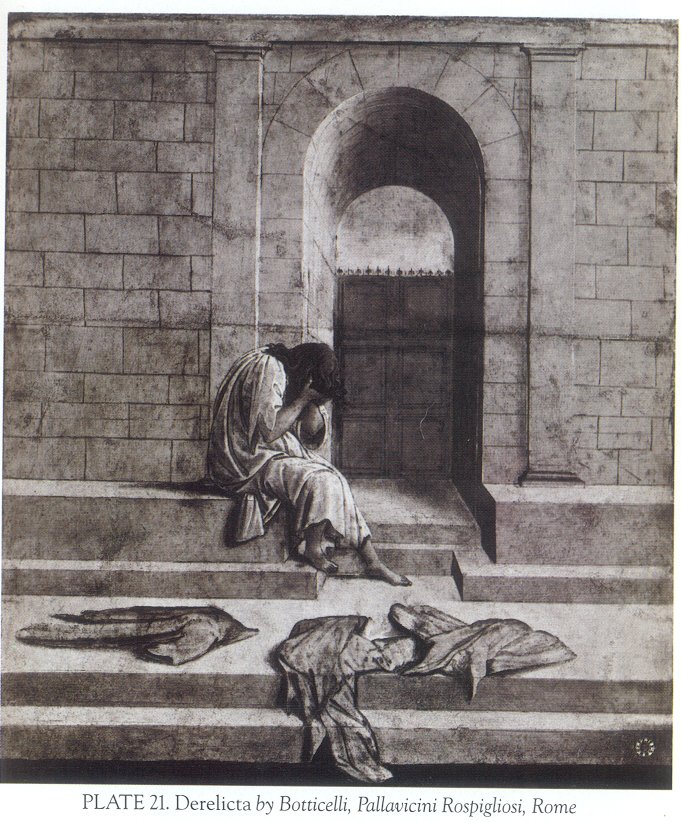
The “abandoned one” represents not just one woman, but ALL! The entire half of the human family born female is subjected to abuse by the “guardians of the walls” who protect the “box” they have created for God, guarding the gates…taking literally the lines in Scripture that gave “Peter” the authority to “bind on earth, bind in heaven.”
There is another place where the “abandoned one” is mentioned–my favorite prophecy: “For Sion’s sake I will not be silent, until her vindication shines forth like the dawn…no longer shall she be called “abandoned” or her lands “desolate,” but she shall be called “Beloved” and her lands “espoused.” — I believe that Mary Magdalene represented the Bride/Daughter of Sion and that when the “Nuptials of the Lamb” are finally celebrated, her presence at the side of Jesus will help to heal the nations.
I’m always amazed at pastors who repeat the “party line” without ever having examined the evidence for the “Sacred Union.” There is no historical evidence (or any evidence) that Mary Magdalene was a prostitute!
Thanks for posting the “Derelicta,” Katia. Unfortunately, it’s not in color in my book. In the original, the torn mantle is rose-colored.In looking again at the picture, I noticed the twin pillars holding up the arch. These pillars, “Boaz and Jachin” mentioned in the Book of Kings, are symbolic of the Temple of Jerusalem, and this reminds me of the “Shekinah” (Bride of Yahweh) whose myth, like Mary Magdalene’s, is another Bride in exile–suffering separation from her Beloved following the destruction of the Temple which cannot be rebuilt because of the “cardiosclerosis” (hardness of heart) that seems to be so prevalent on the planet. The “blueprint” for the New Jerusalem is (as in the Book of Revelation!) the Sacred Union (the “sword” and “cup” triangles intertwined–Star of David). Carl Jung has this right–integration of the “opposites” (Logos/Reason and Eros/relationship) starts in each individual psyche and spreads out into the community and from there into the wider world.
This painting seems to say that the “abandoned one” has been locked out of the “Church” which does not recognize the need for her necessary contribution to the spiritual (and therefore also the emotional and physical) well-being of the community. The “Bride” is being denied access…
In Memory of Her,
Margaret
Thanks for posting the “Derelicta,” Katia. Unfortunately, it’s not in color in my book. In the original, the torn mantle is rose-colored.
In looking again at the picture, I noticed the twin pillars holding up the arch. These pillars, “Boaz and Jachin” mentioned in the Book of Kings, are symbolic of the Temple of Jerusalem, and this reminds me of the “Shekinah” (Bride of Yahweh) whose myth, like Mary Magdalene’s, is another Bride in exile–suffering separation from her Beloved following the destruction of the Temple which cannot be rebuilt because of the “cardiosclerosis” (hardness of heart) that seems to be so prevalent on the planet. The “blueprint” for the New Jerusalem is (as in the Book of Revelation!) the Sacred Union (the “sword” and “cup” triangles intertwined–Star of David). Carl Jung has this right–integration of the “opposites” (Logos/Reason and Eros/relationship) starts in each individual psyche and spreads out into the community and from there into the wider world.
This painting seems to say that the “abandoned one” has been locked out of the “Church” which does not recognize the need for her necessary contribution to the spiritual (and therefore also the emotional and physical) well-being of the community. The “Bride” is being denied access…
In Memory of Her,
Margaret
http://www.margaretstarbird.net/
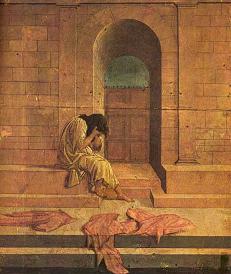
No Longer Derelicta
by Noor, OMM Initiate
I am going home
To my Beloved,
Where I will no
Longer be the
Derelicta.
I am returning to my
Place as the
Glorious and
Magnificent Bride.
I will be Heaven
On High, for I
am going to be
With my King.
Blessed am I
Who holds the Rose
And sits at the
Left hand of
Her Lord.
Blessed am I
Who holds the
Wisdom of
the Universe,
Who walks the
Way in light.
Blessed they will call me
As they bow before me
And weep at my feet.
They shall welcome
Me at gates of gold
With roses and
Garlands and crowns.
And there shall
Be doves, pure
And white, and
Singing sweetly,
And my Beloved
Shall welcome
Me home.
